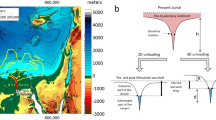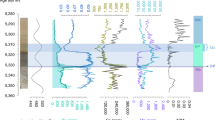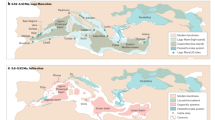Abstract
The Messinian salinity crisis1,2 (5.96 to 5.33 million years ago) was caused by reduced water inflow from the Atlantic Ocean to the Mediterranean Sea resulting in widespread salt precipitation and a decrease in Mediterranean sea level of about 1.5 kilometres due to evaporation3. The reduced connectivity between the Atlantic and the Mediterranean at the time of the salinity crisis is thought to have resulted from tectonic uplift of the Gibraltar arc seaway and global sea-level changes, both of which control the inflow of water required to compensate for the hydrological deficit of the Mediterranean1,4. However, the different timescales on which tectonic uplift and changes in sea level occur are difficult to reconcile with the long duration of the shallow connection between the Mediterranean and the Atlantic5 needed to explain the large amount of salt precipitated. Here we use numerical modelling to show that seaway erosion caused by the Atlantic inflow could sustain such a shallow connection between the Atlantic and the Mediterranean by counteracting tectonic uplift. The erosion and uplift rates required are consistent with previous mountain erosion studies, with the present altitude of marine sediments in the Gibraltar arc6,7 and with geodynamic models suggesting a lithospheric slab tear underneath the region8,9,10. The moderate Mediterranean sea-level drawdown during the early stages of the Messinian salinity crisis3,5 can be explained by an uplift of a few millimetres per year counteracted by similar rates of erosion due to Atlantic inflow. Our findings suggest that the competition between uplift and erosion can result in harmonic coupling between erosion and the Mediterranean sea level, providing an alternative mechanism for the cyclicity observed in early salt precipitation deposits and calling into question previous ideas regarding the timing of the events that occurred during the Messinian salinity crisis1.
This is a preview of subscription content, access via your institution
Access options
Subscribe to this journal
Receive 51 print issues and online access
$199.00 per year
only $3.90 per issue
Buy this article
- Purchase on Springer Link
- Instant access to full article PDF
Prices may be subject to local taxes which are calculated during checkout




Similar content being viewed by others
References
Krijgsman, W., Hilgen, F. J., Raffi, I., Sierro, F. J. & Wilson, D. S. Chronology, causes and progression of the Messinian salinity crisis. Nature 400, 652–655 (1999)
Briand, F., ed. The Messinian Salinity Crisis from Mega-Deposits to Microbiology – A Consensus Report (CIESM Workshop Monographs 30, CIESM, 2008)
Hsü, K. J., Ryan, W. B. F. & Cita, M. B. Late Miocene desiccation of the Mediterranean. Nature 242, 240–244 (1973)
Rohling, E. J., Schiebel, R. & Siddall, M. Controls on Messinian Lower Evaporite cycles in the Mediterranean. Earth Planet. Sci. Lett. 275, 165–171 (2008)
Gargani, J. & Rigollet, C. Mediterranean sea level variations during the Messinian salinity crisis. Geophys. Res. Lett. 34, L10405 (2007)
Babault, J., Teixell, A., Arboleya, M. L. & Charroud, M. A late Cenozoic age for long-wavelength surface uplift of the Atlas Mountains of Morocco. Terra Nova 20, 102–107 (2008)
Iribarren, L., Vergés, J. & Fernàndez, M. Sediment supply from the Betic-Rif orogen to basins through Neogene. Tectonophysics 475, 68–84 (2009)
Spakman, W. & Wortel, M. J. R. in The TRANSMED Atlas: The Mediterranean Region from Crust to Mantle (eds Cavazza, W. et al.) 31–52 (Springer, 2004)
Duggen, S., Hoernie, K., Van den Bogaard, P., Rüpke, L. & Morgan, J. P. Deep roots of the Messinian salinity crisis. Nature 422, 602–606 (2003)
Andrews, E. R. & Billen, M. I. Rheologic controls on the dynamics of slab detachment. Tectonophysics 464, 60–69 (2009)
Clauzon, G., Suc, J.-P., Gautier, F., Berger, A. & Loutre, M.-F. Alternate interpretation of the Messinian salinity crisis: controversy resolved? Geology 24, 363–366 (1996)
Barber, P. M. Messinian subaerial erosion of the proto-Nile Delta. Mar. Geol. 44, 253–272 (1981)
Clauzon, G. The Messinian Var canyon (Provence, southern France): paleogeographic implications. Mar. Geol. 27, 231–246 (1978)
Flecker, R. & Ellam, R. M. Identifying late Miocene episodes of connection and isolation in the Mediterranean-Paratethyan realm using Sr isotopes. Sedim. Geol. 188–189, 189–203 (2006)
Hilgen, F., Kuiper, K., Krijgsman, W., Snel, E. & van der Laan, E. Astronomical tuning as the basis for high resolution chronostratigraphy: the intricate history of the Messinian Salinity Crisis. Stratigraphy 4, 231–238 (2007)
Weijermars, R. Neogene tectonics in the Western Mediterranean may have caused the Messinian salinity crisis and an associated glacial event. Tectonophysics 148, 211–219 (1988)
Comas, M. C., Platt, J. P., Soto, J. I. & Watts, A. B. The origin and tectonic history of the Alboran Basin. Proc. ODP Sci. Res. 161, 555–580 (1999)
Krijgsman, W. Late Neogene evolution of the Taza-Guercif Basin (Rifean Corridor; Morocco) and implications for the Messinian salinity crisis. Mar. Geol. 153, 147–160 (1999)
Garcés, M., Krijgsman, W. & Agustí, J. Chronology of the late Turolian deposits of the Fortuna basin (SE Spain): implications for the Messinian evolution of the eastern Betics. Earth Planet. Sci. Lett. 163, 69–81 (1998)
Govers, R. Choking the Mediterranean to dehydration: the Messinian salinity crisis. Geology 37, 167–170 (2009)
Meijer, P., Th & Krijgsman, W. A quantitative analysis of the desiccation and re-filling of the Mediterranean during the Messinian Salinity Crisis. Earth Planet. Sci. Lett. 240, 510–520 (2005)
Blanc, P.-L. Improved modelling of the Messinian Salinity Crisis and conceptual implications. Palaeogeogr. Palaeoclimatol. Palaeoecol. 238, 349–372 (2006)
Rouchy, J.-M. & Saint Martin, J. P. Late Miocene events in the Mediterranean as recorded by carbonate-evaporite relations. Geology 20, 629–632 (1992)
Ryan, W. B. F. Decoding the Mediterranean salinity crisis. Sedimentology 56, 95–136 (2009)
Blanc, P.-L. The opening of the Plio-Quaternary Gibraltar Strait: assessing the size of a cataclysm. Geodin. Acta 15, 303–317 (2002)
Garcia-Castellanos, D. et al. Catastrophic flood of the Mediterranean after the Messinian Crisis. Nature 462, 778–781 (2009)
Gladstone, R., Flecker, R., Valdes, P., Lunt, D. & Markwick, P. The Mediterranean hydrologic budget from a Late Miocene global climate simulation. Palaeogeogr. Palaeoclimatol. Palaeoecol. 251, 254–267 (2007)
Just, J., Hübscher, C., Betzler, C., Lüdmann, T. & Reicherter, K. Erosion of continental margins in the Western Mediterranean due to sea-level stagnancy during the Messinian Salinity Crisis. Geo-Mar. Lett. 31, 51–64 (2011)
Gerya, T. V., Yuen, D. A. & Maresch, W. V. Thermomechanical modelling of slab detachment. Earth Planet. Sci. Lett. 226, 101–116 (2004)
Villaseñor, A., Spakman, W. & Engdahl, E. R. Influence of regional travel times in global tomographic models. Geophys. Res. Abstr. 5, abstr. EAE03-A-08614. (2003)
Aharon, P., Goldstein, S. L., Wheeler, C. W. & Jacobson, G. Sea-level events in the South Pacific linked with the Messinian salinity crisis. Geology 21, 771–775 (1993)
Schneck, R., Micheels, A. & Mosbrugger, V. Climate modelling sensitivity experiments for the Messinian Salinity Crisis. Palaeogeogr. Palaeoclimatol. Palaeoecol. 286, 149–163 (2010)
Fauquette, S. et al. How much did climate force the Messinian salinity crisis? Quantified climatic conditions from pollen records in the Mediterranean region. Palaeogeogr. Palaeoclimatol. Palaeoecol. 238, 281–301 (2006)
Attal, M. et al. Testing fluvial erosion models using the transient response of bedrock rivers to tectonic forcing in the Apennines, Italy. J. Geophys. Res. 116, F02005 (2011)
Whipple, K. X. & Tucker, G. E. Dynamics of the stream-power river incision model; implications for height limits of mountain ranges, landscape response timescales, and research needs. J. Geophys. Res. B 104, 17661–17674 (1999)
Lavé, J. & Avouac, J. P. Fluvial incision and tectonic uplift across the Himalayas of central Nepal. J. Geophys. Res. 106, 26561–26591 (2001)
Wobus, C. W. Heimsath, A. M., Whipple, K. X. & Hodges, K. V. Active out-of-sequence thrust faulting in the central Nepalese Himalaya. Nature 434, 1008–1011 (2005)
Elliot, W. J., Liebenow, A. M., Laflen, J. M. & Kohl, K. D. A Compendium of Soil Erodibility Data from WEPP Cropland Soil Field Erodibility Experiments 1987 & 88. NSERL Report 3 (Ohio State Univ. and USDA Agricultural Research Service, National Soil Erosion Research Laboratory, 1989)
Attal, M., Tucker, G. E., Whittaker, A. C., Cowie, P. A. & Roberts, G. P. Modeling fluvial incision and transient landscape evolution: influence of dynamic channel adjustment. J. Geophys. Res. 113, F03013 (2008)
Whipple, K. X. & Hancock, G. S. River incision into bedrock: Mechanics and relative efficacy of plucking, abrasion and cavitation. Geol. Soc. Am. Bull. 112, 490 (2000)
Whipple, K. X. Bedrock rivers and the geomorphology of active orogens. Annu. Rev. Earth Planet. Sci. 32, 151–185 (2004)
Turowski, J. M., Lague, D. & Hovius, N. Cover effect in bedrock abrasion: a new derivation and its implications for the modelling of bedrock channel morphology. J. Geophys. Res. 112, F04006 (2007)
Meijer, P., Th, Slingerland, R. & Wortel, M. J. R. Tectonic control on past circulation of the Mediterranean Sea: a model study of the late Miocene. Paleoceanography 19, PA1026 (2004)
Bryden, H. L. & Stommel, H. M. Limiting processes that determine basic features of the circulation in the Mediterranean Sea. Oceanol. Acta 7, 289–296 (1984)
de Lange, G. J. & Krijgsman, W. Messinian salinity crisis: a novel unifying shallow gypsum/deep dolomite formation mechanism. Mar. Geol. 275, 273–277 (2010)
Acknowledgements
We thank P. Meijer, S. Giralt, L. Matenco and C. Ayora for comments and criticisms on earlier versions of the manuscript. This work was funded by the Spanish government through the projects ATIZA (CGL2009-09662), TopoAtlas (CGL2006-05493), TopoMed (CGL2008-03474-E/BTE) and TopoIberia (CSD2006-00041).
Author information
Authors and Affiliations
Contributions
D.G.-C. planned the study, performed the modelling and wrote the paper; A.V. processed and interpreted the seismic data and tomography; and both authors interpreted and discussed the results.
Corresponding author
Ethics declarations
Competing interests
The authors declare no competing financial interests.
Additional information
The source code developed for the calculations can be downloaded from https://sites.google.com/site/daniggcc/research-interests/messinian.
Supplementary information
Supplementary Information
The file contains Supplementary Text, Supplementary References and Supplementary Figures 1-4 with legends. (PDF 2548 kb)
Rights and permissions
About this article
Cite this article
Garcia-Castellanos, D., Villaseñor, A. Messinian salinity crisis regulated by competing tectonics and erosion at the Gibraltar arc. Nature 480, 359–363 (2011). https://doi.org/10.1038/nature10651
Received:
Accepted:
Published:
Issue Date:
DOI: https://doi.org/10.1038/nature10651
This article is cited by
-
50th anniversary review of the Mediterranean desiccation hypothesis
La Rivista del Nuovo Cimento (2023)
-
Depositional modeling of the hydrogenous evaporite salts from the Mediterranean and the Red Sea waters
Modeling Earth Systems and Environment (2023)
-
Sill-controlled salinity contrasts followed post-Messinian flooding of the Mediterranean
Nature Geoscience (2022)
-
Sea-level stands from the Western Mediterranean over the past 6.5 million years
Scientific Reports (2021)
-
The major changes in Alboran Sea and its periphery since the Tortonian
Arabian Journal of Geosciences (2021)
Comments
By submitting a comment you agree to abide by our Terms and Community Guidelines. If you find something abusive or that does not comply with our terms or guidelines please flag it as inappropriate.



